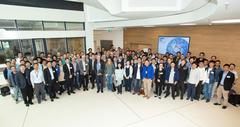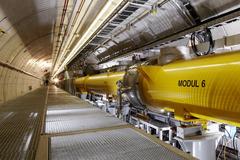URL: https://www.desy.de/news/news_search/index_eng.html
Breadcrumb Navigation
DESY News: CHILFEL – DESY cooperating with China on FEL science and technology
News
News from the DESY research centre
CHILFEL – DESY cooperating with China on FEL science and technology
Scientists from Germany and China want to join forces in the field of free electron laser research: DESY and the Shanghai Institute of Applied Physics (SINAP) have decided to pool their resources in the “CAS-Helmholtz International Laboratory for FEL Science and Technology” (CHILFEL), which will also include the European XFEL and the ShanghaiTech University. The Helmholtz Association today announced that it is going to fund this research collaboration as a Helmholtz International Lab, providing 300,000 euros a year for a period of six years. Together with the funds put forward by DESY and European XFEL and the Chinese contribution of 600,000 euros per year, CHIFEL will therefore be able to draw on total annual funds of 1.2 million euros.

Participants of the German-Chinese workshop that took place at DESY in June. Credit: DESY
China is well on the way to becoming a scientific superpower and has been able to chalk up some significant achievements in the field of free-electron lasers (FEL) in recent years. The leading Chinese players in FEL research are institutions run by the Chinese Academy of Sciences (CAS), such as the Shanghai Institute of Applied Physics (SINAP), as well as the newly founded ShanghaiTech University. In addition to a modern synchrotron radiation source, a free-electron laser for soft X-rays also went into operation in Shanghai some years ago. Approval has recently been given for the ambitious SHINE project, an FEL for short-wavelength X-rays on the Shanghai research campus, based on superconducting accelerator technology.
“These rapid developments in China are opening up numerous new opportunities for DESY to collaborate closely and on eye level, thereby pushing ahead with the development of FELs,” explains Wilfried Wurth (DESY), the scientific coordinator of CHILFEL for the German side. “After a series of several successful workshops, the joint laboratory has now been brought into being, so as to exploit the great scientific and technological potential of the partners for joint research and development tasks in the field of FEL.” The newly founded FEL partnership between Hamburg and Shanghai is receiving substantial support from China’s research policy-makers as a further building block on the way to institutionalised collaboration with the European XFEL.
The scientific programme of CHILFEL will initially be based on five pillars: scientific applications at FELs using soft and hard X-rays; development of FEL methods and instruments; FEL seeding and synchronisation; developing detectors; and the development of superconducting cavities. Overall, 25 scientists from Hamburg and Shanghai are associated with the programme.




